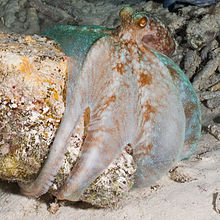- Caribbean Reef Octopus
-
Caribbean Reef Octopus 
Scientific classification Kingdom: Animalia Phylum: Mollusca Class: Cephalopoda Order: Octopoda Family: Octopodidae Genus: Octopus Subgenus: Octopus Species: O. briareus Binomial name Octopus briareus
Robson, 1929The Caribbean Reef Octopus (Octopus briareus) is a coral reef marine animal. It has eight long arms that vary in length and diameter. The "body" is large and chunky in comparison (up to 60 cm long). The Caribbean Reef Octopus is difficult to describe because it changes color and texture in order to blend into its surroundings, using specialised skin cells known as chromatophores. Its color range is incredibly large; it can change from crimson to green, bumpy to smooth. It weighs around 3.3 lb or 1.5 kg.
Contents
Ecology
Habitat and distribution
The Caribbean Reef Octopus lives in warm waters around coral reef environments and grassy and rocky sea beds. Their biogeographic regions are as follows: the Nearctic region, Neotropical region (Central and South America), oceanic islands and the Pacific Ocean.
The Caribbean Reef Octopus lives in hidden, rocky lairs that are difficult to locate. Their lairs are usually created in shallow warm waters. Octopus briareus is not a social animal and does not interact with other Octopus briareus unless mating. If one Octopus was to go into any other Octopuses lair there would be an inevitable fight. Caribbean Reef Octopuses are usually safe from invoking fights if they stay 60 feet away from other octopuses at all times. If faced with a predator a Caribbean Reef Octopus, like most other octopuses, would suck up a volume of water then expel it quickly in the form of a jet to propel itself away from the foe. To further deter predators the Caribbean Reef Octopus can eject oil to mask its escape. The Caribbean Reef Octopus does not live in its lair for its entire life, instead it moves often except while caring for young/eggs.
Prey
The Caribbean Reef Octopus feeds on crabs or shrimp, lobsters, polychaetes and a variety of fish. The Caribbean Reef Octopus is a nocturnal species and only hunts at night.
Predators
The Caribbean Reef Octopus does not seem to have any specialized or outstanding predators. It is preyed on mostly by sharks, stingrays and some other predatory fish.
Reproduction
The Caribbean Reef Octopus mating season lasts for one to two months and is usually around January. The Caribbean Reef Octopus male and female sexes do not have dimorphism between them. The male first "mounts" the females mantle then inserts the hectocotylus, an arm that acts as a "tube" to allow the sperm to enter the female's oviduct. This lasts around half an hour. Octopus briareus usually mates during the day and only the male octopus can initiate or stop the mating process. After the female octopus has been fertilized, it can store the sperm in its oviduct for at most one hundred days. After finding a suitable lair, the female then lays its eggs. Some females have been known to seal themselves in their lair while pregnant. A female can lay up to 500 eggs; clusters of eggs are joined by special stalks. The female then sits with her eggs until they are ready to hatch. If any creatures come near the eggs, the female will attack it, though if it kills the creature, will not eat it. The eggs take 50 to 80 days to hatch, but will hatch more quickly in warmer waters. Newly hatched babies are able to jet propel themselves round and squirt ink, much like their parents. In just 14 weeks the hatchlings are 75% of their full grown size and in just 140 days male hatchlings reach sexual maturity, 150 days for females.
Intelligence
Octopus briareus like most other octopuses is one of the most intelligent of all invertebrates (see Cephalopod intelligence). The octopus's ability to remember where a foe resides and then avoid it is considered to be an intelligent trait. The Caribbean Reef Octopus has also been known to learn from others of the same species and some have disguised themselves as algae and coconuts to avoid predatory detection. The Caribbean Reef Octopus, while not being very aggressive, will turn on a fellow reef octopus and show cannibalistic qualities if many are kept too close to one another.
References
Categories:- Octopuses
- Animals described in 1929
Wikimedia Foundation. 2010.
